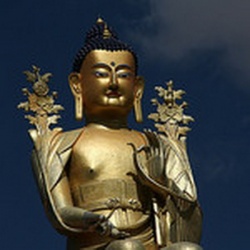Begging bowl
begging bowl
鉢 ( Jpn hachi or hatsu )
The begging bowl or alms bowl (Pali patta; Sanksrit patra) is one of the simplest but most important objects in the daily lives of Buddhist monks. It is primarily a practical object, used as a bowl in which to collect alms (either money or food) from lay supporters.
But the begging bowl also has symbolic significance associated with the historical Buddha. According to one legend, when he began meditating beneath the Bodhi Tree, a young woman offered him a golden bowl filled with rice, thinking he was the divinity of the tree. He divided the rice into 49 portions, one for each day until he would be enlightened, and threw the precious bowl into the river.
This and other legends, combined with its humble monastic uses, have made the simple begging bowl a symbol of the Buddha's teachings on nonattachment. The Vinaya states that monks may use bowls made of either iron or clay, and they can be small, medium, or large.
See; alms bowl.
